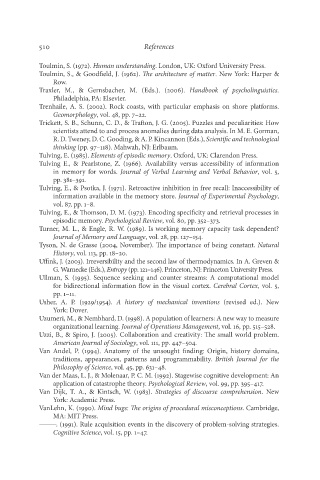Page 527 - Deep Learning
P. 527
510 References
Toulmin, S. (1972). Human understanding. London, UK: Oxford University Press.
Toulmin, S., & Goodfield, J. (1962). The architecture of matter. New York: Harper &
Row.
Traxler, M., & Gernsbacher, M. (Eds.). (2006). Handbook of psycholinguistics.
Philadelphia, PA: Elsevier.
Trenhaile, A. S. (2002). Rock coasts, with particular emphasis on shore platforms.
Geomorphology, vol. 48, pp. 7–22.
Trickett, S. B., Schunn, C. D., & Trafton, J. G. (2005). Puzzles and peculiarities: How
scientists attend to and process anomalies during data analysis. In M. E. Gorman,
R. D. Tweney, D. C. Gooding, & A. P. Kincannon (Eds.), Scientific and technological
thinking (pp. 97–118). Mahwah, NJ: Erlbaum.
Tulving, E. (1985). Elements of episodic memory. Oxford, UK: Clarendon Press.
Tulving E., & Pearlstone, Z. (1966). Availability versus accessibility of information
in memory for words. Journal of Verbal Learning and Verbal Behavior, vol. 5,
pp. 381–391.
Tulving, E., & Psotka, J. (1971). Retroactive inhibition in free recall: Inaccessibility of
information available in the memory store. Journal of Experimental Psychology,
vol. 87, pp. 1–8.
Tulving, E., & Thomson, D. M. (1973). Encoding specificity and retrieval processes in
episodic memory. Psychological Review, vol. 80, pp. 352–373.
Turner, M. L., & Engle, R. W. (1989). Is working memory capacity task dependent?
Journal of Memory and Language, vol. 28, pp. 127–154.
Tyson, N. de Grasse (2004, November). The importance of being constant. Natural
History, vol. 113, pp. 18–20.
Uffink, J. (2003). Irreversibility and the second law of thermodynamics. In A. Greven &
G. Warnecke (Eds.), Entropy (pp. 121–146). Princeton, NJ: Princeton University Press.
Ullman, S. (1995). Sequence seeking and counter streams: A computational model
for bidirectional information flow in the visual cortex. Cerebral Cortex, vol. 5,
pp. 1–11.
Usher, A. P. (1929/1954). A history of mechanical inventions (revised ed.). New
York: Dover.
Uzumeri, M., & Nembhard, D. (1998). A population of learners: A new way to measure
organizational learning. Journal of Operations Management, vol. 16, pp. 515–528.
Uzzi, B., & Spiro, J. (2005). Collaboration and creativity: The small world problem.
American Journal of Sociology, vol. 111, pp. 447–504.
Van Andel, P. (1994). Anatomy of the unsought finding: Origin, history domains,
traditions, appearances, patterns and programmability. British Journal for the
Philosophy of Science, vol. 45, pp. 631–48.
Van der Maas, L. J., & Molenaar, P. C. M. (1992). Stagewise cognitive development: An
application of catastrophe theory. Psychological Review, vol. 99, pp. 395–417.
Van Dijk, T. A., & Kintsch, W. (1983). Strategies of discourse comprehension. New
York: Academic Press.
VanLehn, K. (1990). Mind bugs: The origins of procedural misconceptions. Cambridge,
MA: MIT Press.
———. (1991). Rule acquisition events in the discovery of problem-solving strategies.
Cognitive Science, vol. 15, pp. 1–47.

